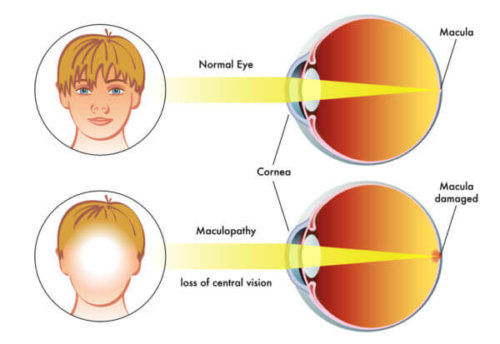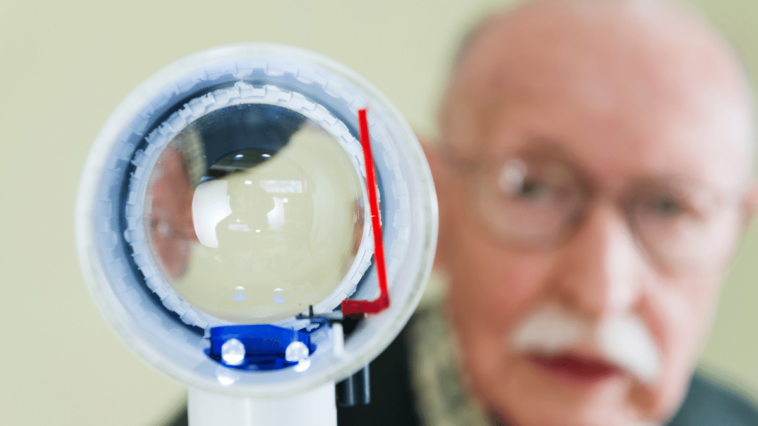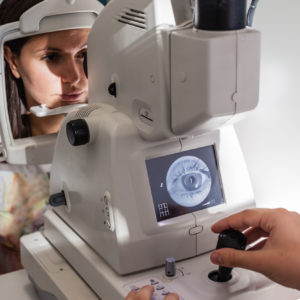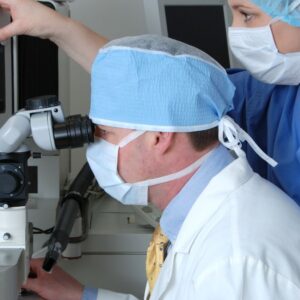What Is AMD?
Macular Degeneration is a retinal disease, which primarily affects older adults.
Every part of the human body comprises different kinds of micro-organs that contribute in totality to function in the best possible manner. Each of these micro-organs has a function to perform routinely. Each of these functions is crucial in its way for the normal functioning of the main organ.
The failure of even a single micro-organ affects the functioning of other organs attached to the same. This becomes all the more complex when it happens to tender organs like the eyes. Human eyes are made up of many minute parts.
The Retina is one of the crucial portions of the eyes which play a vital role in providing clear vision to humans. The Retina is made up of many smaller organs that play a significant role in adding value to Retina’s efforts to provide clear vision.
The Macula is one of the retina parts that allow humans to read, drive, and many more things related to vision. When Macula experiences any Degeneration, it is termed as Macular Degeneration. It is one of the top reasons for vision loss in the globe today.
The Retina, a crucial organ that enables vision, lies at the rear portion of the eyes. The Retina is responsible for recording the images that fall in the line of vision. It records the image for transmitting the same to the brain through the optic nerve found at its rear end. Retina’s central portion is termed as Macula.
Macula’s primary function is to help Retina focus on the central point when looking at objects at varying distances. The Macula is the Retina portion that helps us streamline our focus, providing us the ability to read, drive, and look at objects perfectly. The Macula is made up of thousands of cells.
When these cells start getting affected for many reasons, they slowly deteriorate. Early stages of cell deterioration in the Macula does not cause any harm to vision. However, when damage reaches advanced levels, vision is lost completely. Macular Degeneration is considered an incurable eye disease.

What Causes Macular Degeneration?
Medical Science is yet to find the primary cause for Macular Degeneration though it is associated mostly with aging. In general, AMD can be caused due to the following reasons, in any case.
Aging, which is a scientifically proven cause
Hereditary and factors related to the same
Environment-related factors that deteriorate Eye health
Stargardt disease, which is associated with genetic issues
Certain epidemics can cause Macular Degeneration.
Types of Macular Degeneration
AMD is generally classified into two types. Some informative facts about both types of AMD are given below for a clearer understanding of the same.
1. Dry Macular Degeneration
Dry Macular Degeneration is termed as an Atrophic type or not Neovascular.
Dry Macular Degeneration is referred to as non-Neo vascular since this type lacks new blood vessels’ growth.
When the tissues in the eye muscles get thinned, Dry Macular Generation is caused.
Aging is another factor that causes Dry Macular Generation.
When pigments get deposited on Macula, Dry Macular Degeneration is caused.
A mix and match of the above causes also act as the basis for Dry Macular Degeneration.
Dry Macular Degeneration does not cause vision loss immediately. However, the prevalence and advancement of the same degenerate Macula hugely affecting the central vision spread over some time.
When Dry Macular Degeneration happens, the Macula gets surrounded by what is referred to as ‘Drusen’ in medical terms. Drusen is nothing but the yellow spots caused due to the degenerated condition. In short, the debris of the degenerating tissues in the Macula region is called ‘Drusen.’
2. Wet Macular Degeneration
Wet Macular Degeneration is considered as the Exudative type or Neovascular.
It is termed Neo Vascular since new blood vessels’ growth is found in the Retina’s rear portion. These blood vessels start leaking fluid and blood, causing severe damage to the cells in the Retina, which are highly light-sensitive.
New blood vessels are created in the Retinal area owing to the human body’s efforts to develop an extra network for free blood flow. When this scares the Retina and causes damages to the region, Wet Macular Degeneration is caused.
Wet Macular Degeneration is divided into two types, namely Classic Neovascular and Occult Neovascular.
When the bottom portion of the Retina displays heavy scarring due to new blood vessels’ growth, it is termed as Classic Neovascular or CNV in medical terms.
When the bottom portion of the Retina displays mild scarring due to new blood vessels’ growth and minimal leakage of fluid and blood, it is termed Occult Neovascular in medical terms.
Stages of Macular Degeneration
AMD can be classified into three stages when it is caused due to aging.
Early Age-related Macular Degeneration
Age-related Macular Degeneration is termed AMD. Macular Degeneration usually does not show up during the early stages. It remains highly docile though yellow deposits termed as Drusen forms underneath the Retina.
Early state age-related Macular Degeneration can be identified only through Eye examinations done regularly in a periodic manner.
Intermediate Age-related Macular Degeneration
This stage is slightly advanced by every bit. Though there may not be visible symptoms during this stage, comprehensive tests specifically available for the purpose will help identify Macular Degeneration’s advancement.
These tests will help the Eye Care Professional identify changes in the pigmentation aspect of the Retina. They will also help the identification of large-sized Drusen.
Late Age-related Macular Degeneration
This is the advanced stage of AMD. Vision Loss will be blatantly noticeable. AMD would have reached such a stage where vision cannot be brought back to normalcy.
Who Are at Risk of Macular Degeneration?
People who fall under specific categories based on lifestyle and ethnicity are prone to be experiencing Macular Degeneration more than others outside these categories’ boundaries. Some types that can make people fall prey to AMD are listed below for clarity.
- People who regularly smoke.
- People who suffer from high levels of blood pressure.
- People who are obese, significantly overweight in and around the abdomen region.
- People who suffer from Cardio Vascular ailments.
- They are exposing the eyes to the sun rays directly without protective mechanisms like coolers.
- Aging.
- Genetics.
- People were having a family history of Macular Degeneration.
- People who have irises or irides are light-colored.
- Excessive levels of CRP in the body (C-Reactive Protein)
- Gender – since females tend to get affected by Macular Degeneration more than men.
- Lifespan: Females generally live longer than men and are easily susceptible to be affected by Macular Degeneration.
- They are Consuming junk food regularly for long periods of duration.
- They are exposing the eyes directly to any ultraviolet rays and Blue rays.
- Medications administered for the treatment of other diseases or health conditions
- People who are non-African Americans, Latinos, and Hispanics are prone to developing Macular Degeneration than people who belong to these races. This may be attributed to the environment they live in.
Diagnosis for Macular Degeneration
There are many types of tests available for diagnosing AMD. These tests identify the presence of Drusen to ascertain Macular Degeneration emphatically. The fact of fewer numbers of Drusen indicates the initial stages of AMD.
The presence of large-sized Drusen indicates the 2nd stage of Macular Degeneration and needs immediate medical care to keep the Degeneration under control. Tests for diagnosing Macular Degeneration show the prevalence of the same by bringing out the changes in the Retina in terms of pigments. Breakage and release of pigment in the Retinal area make them form clumps that are dark-colored.
The presence of these clumps in the Retina indicates Macular Degeneration. Comprehensive Eye tests that bring out Drusen’s presence or pigmentation changes in the Retina are listed below to understand all concerned.
- Amsler Grid – This is a grid that has lines in a crisscross manner. If you have AMD, these lines will look wavy or disappear from your central vision. The Eye Doctor checks for these symptoms during the test to ascertain if you have AMD.
- Visual Acuity Test – This is the basic test done by the Eye Doctor to ascertain your ability to read alphabets of varied sizes from varying distances.
- Optical Coherence Tomography – This test provides images of tissues in high-resolution eyes with the light rays that penetrate the eyes. These powerful light beams are focused inside the patient’s eyes to ascertain the kinds and levels of damage that are happening to the various parts of the eyes.
- Dilated Eye Exam – This is one of the necessary tests done on patients who come to an Eye Doctor with eye-related problems. Dilation of eyes helps the Eye Doctor look at the rear portion of the eyes. The Eye Doctor checks the Retina and the Optic Nerve to ascertain if the eyes are experiencing Macular Degeneration.
- Fluorescein Angiogram – This is an advanced level exam conducted in patients by a qualified Ophthalmologist to ascertain leakage from the blood vessels in the eyes. The fluorescent dye is generally injected into the arms of the patient. Pictures of the dye passing through the blood vessels in the eyes bring out specific vessels that leak blood. This will help the Eye Doctor decide on the stage of Macular Degeneration and further course of treatment.
Macular Degeneration Treatment
AMD, in reality, does not have any cure. However, certain things can help people avoid getting into the condition.
Early Macular Degeneration
Healthy diet
Regular exercise regime
Getting out of smoking
Safeguarding the eyes from harmful exposures to ultraviolet and blue rays
Intermediate Macular Degeneration
Regular Intake of Minerals and Vitamins that can add nutritional value to the health
If you have been diagnosed with Intermediate level Macular Degeneration, check with your Eye Doctor about the possible nutrition supplements you can take daily to slow down the disease’s progression.
Advanced Macular Degeneration
There are no medicines that avoid permanent vision loss at an advanced stage of Macular Degeneration. Eye Doctors do offer therapies and treatments to the patients. Such therapies are not for curing Macular Degeneration. Macular Degeneration can still worsen based on various other factors.
1. Photodynamic Therapy – In this therapy, a particular medicine available for the purpose is injected into the blood veins in the patient’s arms. This medicine that travels through the vein goes into the new blood vessels created in the Retinal region. When the Eye Care Professional activates this medicine inside the new blood vessels created behind the Retina, the blood vessels get blocked. This slows down the growth of the blood vessels while at the same time slowing down the speed with which the vision is lost.
2. Anti-VEGF Injections – The protein named VEGF is responsible for the growth of new blood vessels. When Anti-VEGF injections are administered on patients, it automatically blocks new blood vessels’ growth, thus slowing down the Macula’s speed of Degeneration in the Retina.
3. Laser Surgery – In this treatment option, the abnormal newly formed blood vessels in Macula gets destroyed by the hot laser rays beamed on them.






